The American brand Ayre, of which this QX-5 Twenty Digital Hub (a network player equipped with many digital inputs) will be the first device to be subject to one of our testing grounds, has an excellent reputation with demanding music lovers and specialist magazines.
We’ll reuse—not in any advertorial spirit, but because as we write this introduction the technical and sound parts of the testing ground of the QX-5 Twenty are already completed—part of the presentation that the importer gives of the brand and which perfectly suits the feelings that we had while testing this device.
So, what’s the point in rewriting what’s already so well said by Sound & Colors, the brand importer:
Combining stunning realism with exceptional clarity, AYRE components offer a natural, relaxed presentation that draws you into your favorite music and films as never before. All of AYRE’s products employ exclusively fully-balanced, zero-feedback circuitry, with special emphasis lavished on the power supply.
We’ve indeed discovered a unique design during the technical analysis, and felt a natural sound reproduction with exceptional clarity and finesse when we listened to this Ayre QX-5 Twenty Digital Hub.
This device also offers compatibility with the mconnect control and mconnect control HD integrating respectively the Qobuz application and the Qobuz application in Hi-Res. A detailed article including a tutorial regarding these applications will be released soon. It’s also compatible with the Roon music player application.
After all these tantalizing words, let’s now dive into the testing ground of this Ayre QX-5 Twenty.
Presentation
According to us, seriousness, functionality and sturdiness characterize the design of the Ayre QX-5 Digital Hub. However, its design is still pleasing and balanced in its all natural anodized solid aluminum dress.

The central part of the facade is occupied by a large blue display, its bottom part hosting, in a very discreet fashion, four Jack plugs devoted to headphone listening, on the left one in 6.35mm standard format and another in 3.5mm standard format, while on the right two 3.5mm Jack will allow you to connect a pair of headphones running in symmetrical mode that you can operate by pushing the button located on the left of the display—a button that is also used to navigate the menus.
You’ll find a symmetrical button on the right of the display, which is used for the mute and standby functions.
Connectivity
Hub is the right word to describe the rich connectivity of the Ayre QX-5, which displays a nice range of digital inputs.
We thus count, in numerical order, two inputs in the professional standard AES/EBU on female three-pin XLR plugs, three coaxial S/PDF inputs on bayonet style connector (BNC) requiring the use of an adapter or a BNC/RCA cord if the connected device possesses RCA outputs, or a BNC/ BNC 75 Ω cord if the connected device has a BNC output (which is the ideal solution, from a theoretical standpoint).

Then come three Toslink optical S/PDIF inputs, two Airlink specific connectors on RJ11 sockets, a USB A socket to update the firmware and an asynchronous USB B socket to connect the device to a computer.
In the top part of the back side, a wired network RJ45 socket is located next to two USB A sockets that can be used to connect two USB storage media or one and its supplied Wi-Fi antenna. Let’s note that the Ayre QX-5 Twenty’s wired network part (that we’ve used in our tests) doesn’t work in gigabyte connection and that you’ll need to use its Ethernet switch in auto-negotiation mode.
The stereo analog audio signals are available in standard asymmetrical mode on RCA or in symmetrical mode on three-pin XLR plugs. A Toslink optical output delivers a high-precision clock derived from the QX-5’s ultra-low phase noise master clock.
Manufacturing
When you open the Ayre QX-5 Twenty Digital Hub, two things attract the eye, not to say impress, and that’s the number of 10,000 μF/16V electrochemical capacitors, namely eighteen (twelve for the digital circuits and six for the power supply of the symmetrical preamplification), and four 3,300 μF/35V for the asymmetrical preamplification, as well as the circuits with the many components that you can see in the bottom left of the picture, corresponding precisely to this preamplification.
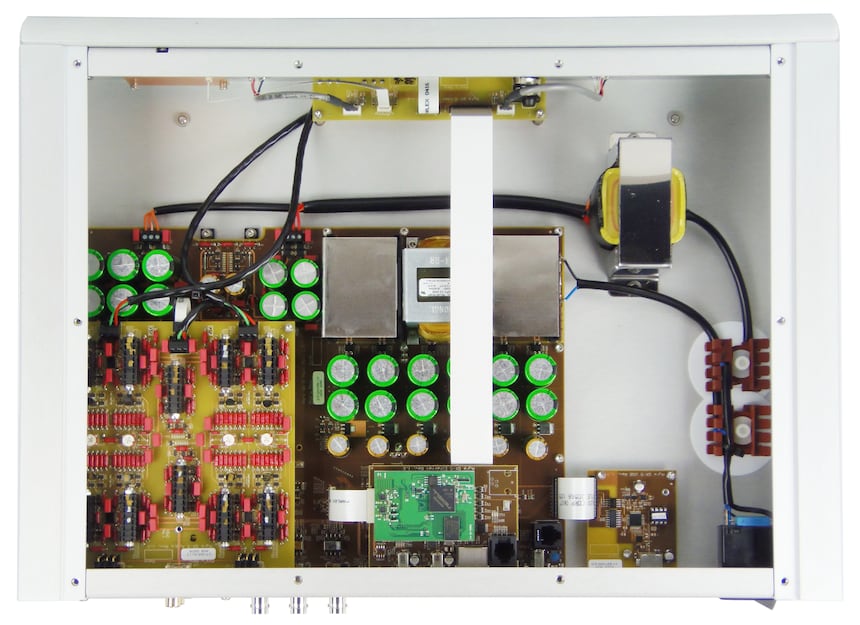
You’ll also note that the mains wires make several turns around ferrite mandrels to filter parasitic noises and that the analog part has a standard transformer, while a switch-mode power supply devoted to the digital circuits is integrated into the main circuit board.
The USB interface occupies the small card located on the right of the main circuit. It uses a SMSC USB3343 associated to a XMOS processor which extracts the I2S bus. On its left, you can see the network card (from Conversdigital, the creator of the mconnect application) with its RJ45 connector and its two USB A sockets. The processing of the signals streamed on the network, on the Internet or coming from the other digital inputs is handled by a Xilinx Spartan programmable circuit, which does a Single-pass 16x oversampling, and alongside which you can see a PIC32MX470 microcontroller.

The S/PDIF and AES/EBU inputs are isolated by impedance conversion transformers, and are commuted and processed by an Asahi Kasei AK4118 (24-Bit/192 kHz) S/PDIF digital audio transceiver.
The digital-to-analog conversion is handled by the new high-end eight-channel chip from ESS, the ES9038Pro Sabre, which uses the Hyperstream®, a proprietary technology involving a 32-Bit recalculation at high frequency of each and every digital signal (both PCM and DSD), as well as the Time Domain Jitter Eliminator process. The eight channels are probably used in groups of four on each stereo channel to improve the signal-to-noise ratio. You can also note the quality of the passive components used around this circuit.
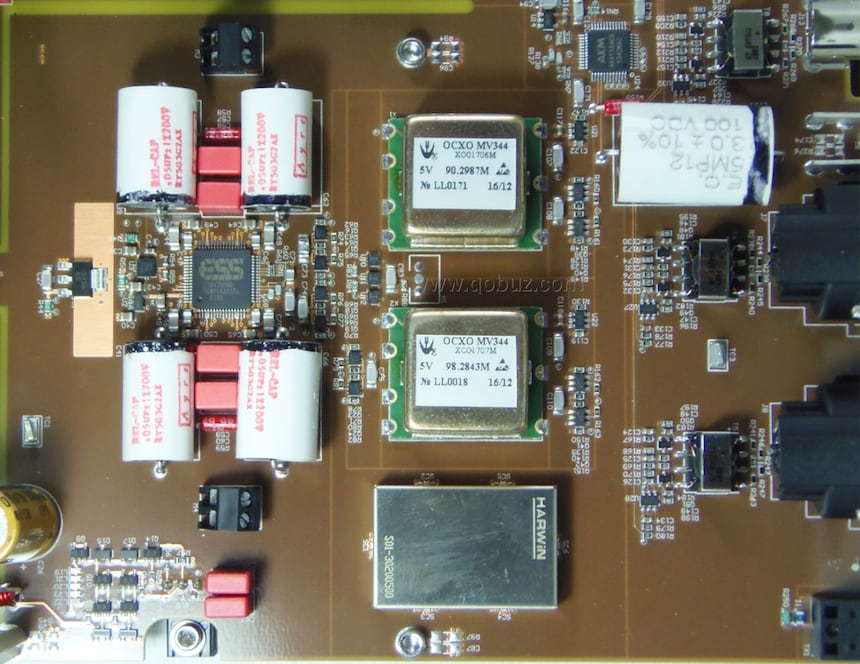
However, we were quite intrigued with the presence next to this chip of two OCXO (Oven Controlled X-tal Oscillator, literally an oven in which the temperature is kept constant to avoid any frequency drift—a luxury solution) oscillators running at 90.2987 MHz et 98.2843 MHz, when usually the ESS chips use only one oscillator, generally running at 100 MHz, for their internal clock.
After making all the calculations, these frequencies correspond respectively to 2048 times 44.1 kHz and 2048 times 48 kHz, i.e. integral multiples of these frequencies (2048 = 211). If we’re not mistaken, it means that the ES9038Pro chip will use, depending on the sampling frequencies of the digital audio signals to process, the appropriate oscillator, thus working internally with frequencies that are integral multiples of these signals in synchronous mode, and not in asynchronous mode as it is the case with a unique 100 MHz oscillator—which is neither an integral multiple of 44.1 kHz nor of 48 kHz.
It’s a smart solution which, as we noticed during our listening tests, avoids the natural tendancy of the Hyperstream® technology, used basically so to speak, to deliver a rather bright signal due to a clock that is not synchronous with the incoming signals, which requires calculations that don’t preserve the natural sound, according to our frequent observations—especially at high frequencies. In fact, the ESS chip doesn’t work here as a sampling rate converter, but rather as an oversampler.
But the analog part (signal filtering and symmetrizing), with its structure as we had never seen, also helps to obtain the exceptional sound results that we have enjoyed.
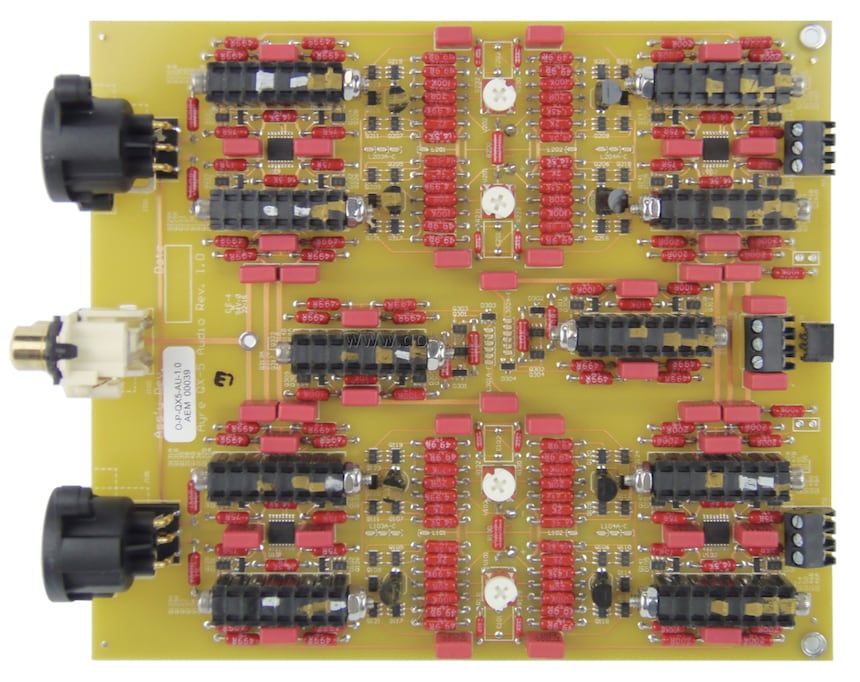
The latter actually seems to use the two stages located in the central part of the card for the filtering, with groups of eight transistors thermally coupled and probably mounted in parallel to improve the signal-to-noise ratio. The manufacturer also indicated that this card functions without any feedback; in short it’s only good things in there.
On both sides of the card, you’ll find symmetrical preamplification circuits (at a rate of two per channel mounted in parallel, or so it would seem), also using groups of eight transistors thermally coupled and 2SK170 and 2SJ74 field-effect transistors—models that are regularly used for low-noise preamplification. The commutation between the Music, Video and Measurement modes is entrusted to Analog Devices ADG123 analog relays. The symmetrical signals are then available on the XLR plugs, while only their positive part is available on the RCA outputs.
The headphone out signals are taken from this card, at the level of the external speaker terminals located on the right of the picture, and you’ll get the same sound quality as with the analog outputs.
You’ll also note that the passive components chosen are of very high-quality, like the high-precision low-noise resistors and the Wima MKC polycarbonate-layered capacitors, which are among the cream of the crop.
Therefore, you can see that everything has been made to reduce background noise, as much at the level of the ESS chip as in this analog part.
Sound
By choosing the Music mode in the input settings (playback mode), the Ayre QX-5 Twenty Digital Hub offers a particularly beautiful and soft sound restitution of the splendid Psalm 142 from Felix Mendelssohn’s album Sacred Choral Works performed by the Chamber Choir of Europe and the Württembergische Philharmonie Reutlingen conducted by Nicol Matt. It begins with chords arising from the silence like a sunrise preceding the chorus singing Wie der Hirsch schreit, with a splendor that gives you goosebumps.
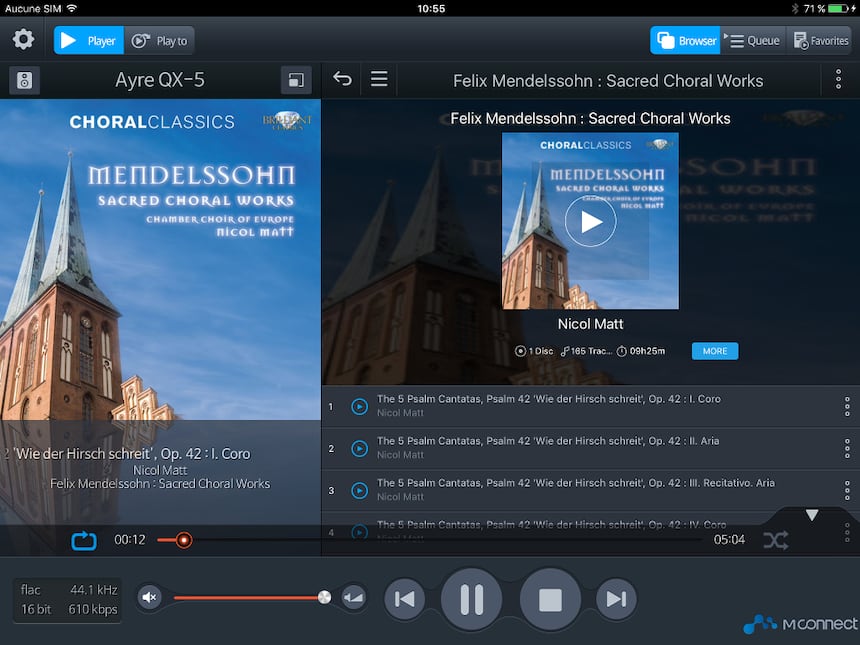
The music is reproduced with great fluidity, the orchestra and the choruses are one, as well as the soloists who don’t try to impose themselves but fall in line with a sound continuity tinged with beauty and spirituality, and the sonic transparency of our small Sony UDA-1 amplifier associated to our Triangle Antal Anniversary speakers lends itself well to this restitution.
The gapless playback being an important point for network players, we’ve discovered with great satisfaction that it could be set up by displaying the Information on the device after clicking on the small speaker in the top left corner of the screen.
And to check this functionality, we have chosen to listen to Henry Wood’s Fantasia on British Sea Songs which is a succession of different scenes, those being otherwise also particularly well-adjusted to the sound measurements of a device by their richness of climate, colors and range.
No doubt regarding the gapless then, and as for sound quality, the diverse scenes are magnificently reproduced with their own character, and we notice even more than previously that the sound message benefits from a rather unusual aeration and finesse, especially while listening to The Saucy Arethusa, while the singing from Tom Bowling ’s violins stretches with languor and would almost make us forget that we’re listening to a sound reproduction system. Anyway, this is some great stuff.
While listening to the album Renaud (Bonus Edition), clarity and aeration reign supreme with a sound restitution being of (almost) studio quality, where you follow every inflection from the singer’s voice and all the richness and nuances from the accompaniments. It’s very pleasing and never grows tiresome.
Of course, we have heard darker renderings of the eponymous title from Leonard Cohen’s testament album You Want It Darker, but not as precise on the singer’s voice intonations, the definition of the accompaniment and the choruses, and, in any case, the sound reproduction from the Ayre QX-5 Twenty Digital Hub keeps the emotional power of this prophetic song intact.
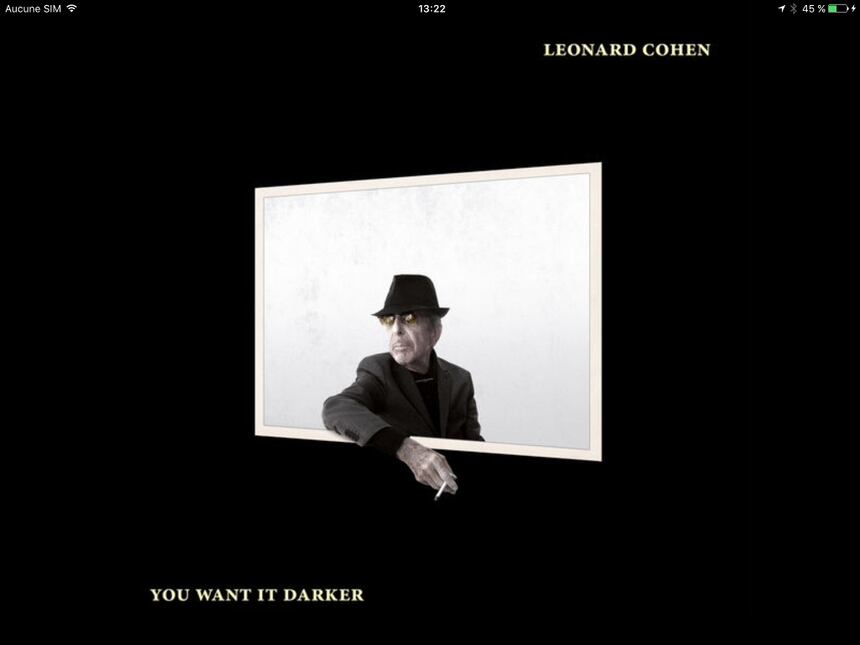
Just a word on the headphone out, it’s very good too, as good as the speaker out, with great aeration and also great feeling of spacing.
To conclude, this Ayre QX-5 Twenty Digital Hub is an exceptional device to which we bestow a Qobuzism. It offers sound performances unlike any we’ve heard before, with the associated elements, amplifier and speakers, not even belonging to the same league—even if we like them a lot. It’s highly promising for the lucky ones who can afford it and associate to it elements of the same ilk!
Sound & Colors-GT Audio Website (Importer)


